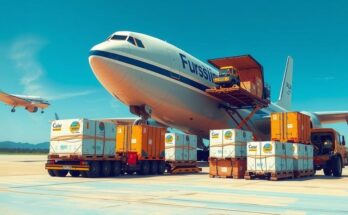The aviation industry is increasingly affected by climate change, as highlighted by several recent incidents involving severe turbulence and operational disruptions. Researchers link these aviation challenges to global warming, emphasizing the growing frequency of dangerous weather patterns and turbulence. Countries like Türkiye also face consequences, with extreme weather impacting airport operations. Experts recommend enhanced forecasting and infrastructure resilience to mitigate these risks moving forward.
The aviation industry faces significant turbulence due to climate change. The year 2024 revealed stark incidents such as a seaplane crash in Australia and a mid-air collision in D.C. These occurrences raise concerns about the mounting connection between climate change and aviation safety, particularly as air travel becomes increasingly common. As we enter 2025, the unsettling pattern of incidents suggests that climate-related challenges are intensifying.
Historically, incidents such as the Spice Jet flight turbulence in May 2022, which left passengers in panic, highlighted this critical issue. Other flights, including those from Singapore Airlines and Qatar Airways, encountered severe turbulence, emphasizing the risk to travelers. Experts now strongly advise passengers to “tighten up your seat belts” amid persistent flight instability, underscoring the need for caution when flying.
Research indicates that Clear Air Turbulence (CAT), a particularly dangerous form of turbulence, is expected to rise as the planet warms. Though not typically a cause for aircraft failures, increasingly severe turbulence poses health risks for passengers and increases stress for pilots, indicating a growing problem. Consequently, while short-term flight safety may not be compromised directly, the future of air travel remains fraught with challenges due to escalating climate impacts.
Additional research from the University of Reading underscores that turbulence has surged by 55% since four years ago, particularly affecting high-traffic air routes. Jet streams play a crucial role in aviation and are being disrupted by rising temperatures. This weakening of jet streams, resulting from climate change, enables more severe weather, including storms and heavy rains, potentially complicating flight operations and inflating travel costs for passengers.
Climate change’s impact varies worldwide, with Türkiye’s aviation sector suffering from extreme weather events causing operational issues. While Türkiye has not experienced a specific aviation disaster linked to climate changes, the related global incidents serve as warnings. Flooding and heatwaves threaten airport infrastructures, resulting in delays and cancellations as planes struggle with reduced air density during hotter conditions.
Moreover, the increased frequency of strong winds and storms complicates take-off and landing protocols, which can lead to flight diversions and rising operational costs. With climate change creating a precarious scenario for aviation, experts urge improvements in forecasting and infrastructure resilience. Right measures must be implemented to mitigate the detrimental effects of climate change on air travel now to ensure safety and reliability for future flights.
In summary, climate change significantly threatens the aviation industry, introducing increasing turbulence and operational challenges. Recent incidents underscore the urgent need for improved forecasting, resilient infrastructure, and strict safety measures in the face of evolving climate impacts. Stakeholders must act decisively to navigate the turbulent skies ahead and ensure passenger safety and comfort. Ignoring these challenges could lead to further risks and increased costs in the aviation sector.
Original Source: www.turkiyetoday.com




